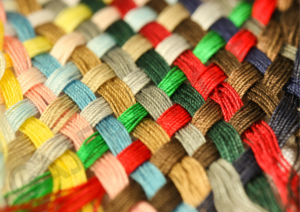Weaving is the one of the oldest, most widely used and most common method of fabric production. Weaving is the interlacement of two sets of yarns; the warp yarn run vertically through the length of the fabric and weft yarn run horizontally across the width of the fabric. Each thread or yarn in a warp direction is called an end, and each thread in the weft is called a pick, or in the American term it is called filling. Warp yarns are usually stronger and more compact than the weft or filling yarns.

Picture: Weaving Process Overview
Usually warp threads are oriented in the direction of production, and the weft threads are oriented perpendicular to the direction of production. The warp threads are stored on a warp beam. Depending on the width of the fabric, several hundred to thousands of warp threads are wounded onto a warp beam. From the warp beam the warp threads are guided through several harness frames. Sometimes the harness frame also referred as a Heald frame. These harness frames can be moved up and down, pulling a part of the warp threads with them. In the space between the warp threads (called the shed), the weft thread can be inserted. After the weft thread has been inserted into the shed, the reed beat up the weft thread against the fabric. After that, the harness frames move in opposite directions, binding the weft thread into the fabric and another weft thread insertion cycle will begin. There are several methods for inserting the weft yarn into the fabric, the most common methods are by using shuttle, rapier and air jet technology (Read more here in our other Blog). After the weft insertion and the reed beat up process, the produced fabric is rolled up on the cloth beam or a fabric beam.

Picture: Detailed view of the weaving process
Now, let’s break down the process and understand step by step weaving process in more detail. Forming a woven fabric requires five basic loom motions: shedding, weft insertion, beat up by reed, let-off, and take-up. The first three motions shedding, weft insertion and beat-up take place in a set time interval and follow one another sequentially. Because these motions cannot happen simultaneously.
The warp yarns are coming from the warp beam. The warp beam holds the warp yarns, which are then threaded through the loom and held under tension. Tension on the warp is necessary in order to form a clear opening of warp yarns, or shed, for insertion of the weft yarns. Warp yarns experience stress, strain, and abrasion as they move up and down when they forming the shed.
After the yarn is passed from the warp beam in weaving, the process involves threading the warp ends through the loom’s heddles and reed, then raising and lowering warp threads to create a “shed” for the weft to pass through, followed by beating the weft into place. These raising and lowering process called the shedding.
Shedding is one of the most important principles of weaving process. Shedding is the process of separating the sheet of warp into two layers one at the top and another at bottom making a V-shape opening for the filling (weft) yarn to pass through. This opening is called a shed. Different mechanisms are used for the shed formation. These shed formation machines include shaft, cam, dobby, servo drive and Jacquard (Read more here in our other Blog).
Weft insertion is the second important motion after shedding in the weaving process. Weft insertion is the process of inserting the weft yarn in between the top and bottom layers of warp shed. This can be achieved by means of a shuttle in shuttle weaving and by means of a different weft insertion technology such as projectile, rapier and a jet of air or water in shuttle less weaving.
After the shedding and weft insertion process, the beat-up process takes place. Beat-up is the process of pushing the newly inserted weft yarn into the fell of the cloth by means of reed. Reed is a rectangular closed comb of fat metal strips placed closely with small spacing. The reed pushes the newly inserted weft against the fell of the cloth. This spacing corresponds to the spacing between the warp yarns. The spaces between two metal strips are called dents. The fell of the cloth is the meeting point of the warp yarn and fabric.
When the reed beat up the newly inserted weft yarn, a warp let-off mechanism releases the warp yarn from the warp beam at uniform tension as the weaving proceeds. The let-off mechanism controls tension in the warp yarn by controlling the rate of flow of warp yarn. This let-off process is done by positive off motion and negative let of motion. After the let-off process, the fabric is completely weaved and now it has to take-up or rolled it to the fabric beam. Fabric take-up is an important function in a loom because it controls the quality of the fabric in terms of picks per unit length, which is also referred as pick density.
This is how the weaving process is done from starting the weaving preparations to the weaved grey fabric. For more information and practical experience, we would like to invite you to visit our company GAJERA IMPEX personally. Do not hesitate to reach us for more information or any inquiry.
📩 Contact Us Today to Place Your Order!




